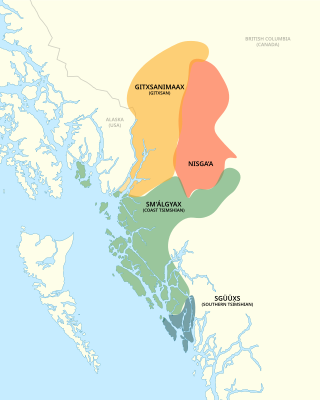Top Qs
Timeline
Chat
Perspective
Gitxsan language
Tsimshianic language of Canada From Wikipedia, the free encyclopedia
Remove ads
Gitxsan /ˈɡɪtsæn/,[2] or Gitxsanimaax (also rendered Gitksan, Giatikshan, Gityskyan, Giklsan and Sim Algyax[3]), is an endangered Tsimshianic language of northwestern British Columbia, closely related to the neighboring Nisga’a language. The two groups are, however, politically separate and prefer to refer to Gitxsan and Nisga'a as distinct languages. According to the Report on the status of B.C First Nations Languages[4] there are 523 fluent speakers, 639 that understand or somewhat speak and 344 learning speakers.[4]
Gitxsan means "People of the river of mist", referring to the Skeena River.
Remove ads
Dialects
Gitxsan language is primarily separated into Geenix[3] or Eastern and Gyeets[3] or Western Gitxsan, although each village has its own dialect. The Geenix[3] or Eastern villages include Kispiox (Ansbayaxw), Glen Vowell (Sigit'ox), and Hazelton (Git-an'maaxs). The Gyeets[3] or Western villages include Kitwanga (Gjtwjngax), Gitanyow (Git-antaaw) and Kitseguecla (Gijigyukwhla). The main differences between dialects include a lexical shift in vowels and stop lenition use present only in the Eastern dialects. The largest differences in language and culture exist between Eastern and Western Gitxsan, rather than between each village.[5]
Remove ads
History and usage
The University of Northern British Columbia and Siiwiixo'osxwim Wilnataahl Gitksan Society (Gitksan Language Society) set up a Developmental Standard Term Certificate program offered through Northwest Community College, with all courses offered in Hazelton, British Columbia. The program is designed to help revitalize Gitxsan language by allowing those who complete it to teach language and culture courses at the elementary and secondary school level in the community.[6]
In the spring of 2018, an online dictionary app was released in collaboration with members of Gitksan Nation and researchers at the University of British Columbia. The app includes various dialects of Gitxsan, and includes audio from different villages. Flashcards, stories, and histories are also included in addition to functioning as a dictionary. This app is based on a print dictionary produced in 1973 by Lonnie Hindle and Bruce Rigsby. With its launch, the app briefly held a top spot in Google Play's education category and accumulated around 500 downloads in its first week.[7]
Remove ads
Phonology
Summarize
Perspective
The Gitxsan inventory is as follows:[5][8]
The mid and high vowels are nearly in complementary distribution, suggesting that Gitxsan once had a three-vowel system. Short mid vowels are emerging. Schwa only occurs in unstressed syllables. /eː/ and /oː/ have short allophones [e] and [o] in certain positions.
Voiceless stops have voiced allophones [b d d͡z ɡʲ ɡʷ ɢ]. The pre-velar obstruents become velar before /s/ and /l/. The lax glottalized stops "display a creaky voice quality at the margin of the vowel in pretonic (and syllable-final) environments."[8] The glottalized consonants may be ejective in word-initial position, but otherwise "are characterized by glottal closure preceding the oral closure." The ejective allophones are lenis, and are therefore sometimes perceived as voiced. Lenis ejectives are unusual for the area, but are also found in neighboring Witsuwitʼen. The glottalized sonorants are preglottalized even in word-initial position. Glottalization ranges from a full glottal stop [ʔC] to creaky voice [C̰].[5]
References
Further reading
External links
Wikiwand - on
Seamless Wikipedia browsing. On steroids.
Remove ads


